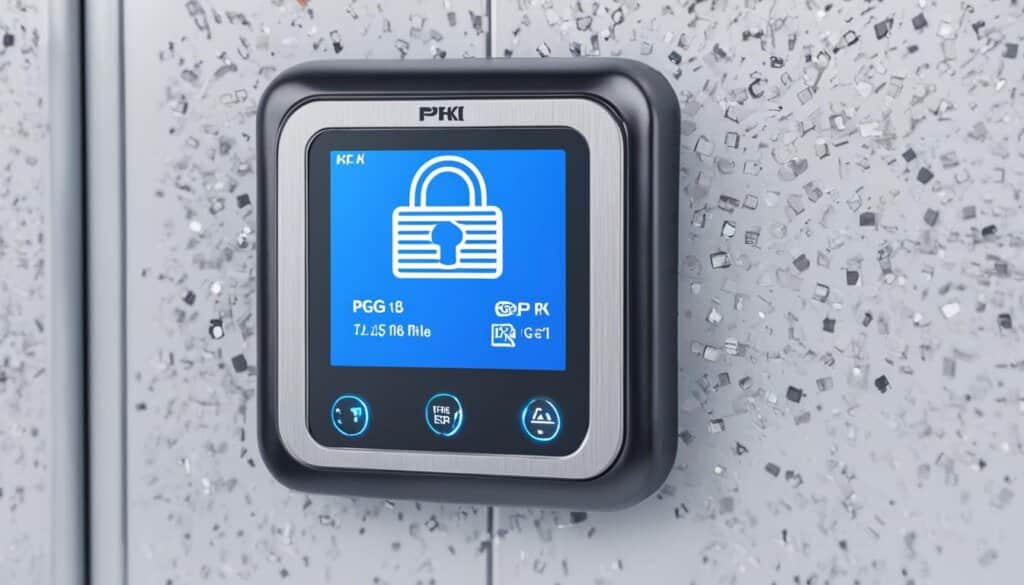Table of Contents
Welcome to our guide on digital signatures, an essential component of electronic signatures in today’s digital world. In this comprehensive article, we will explore the intricacies of digital signatures, highlighting their importance in ensuring authenticity, integrity, and online authentication.
We live in an age where online interactions have become the norm, whether it’s signing contracts, sending sensitive documents, or conducting financial transactions. With this shift to the digital realm, the need for robust security measures has never been greater.
Digital signatures offer a solution to these challenges, providing a trustworthy method to verify the identity of the sender and protect the integrity of electronic messages and documents. By utilizing mathematical algorithms and encryption techniques, digital signatures create a virtual fingerprint unique to the sender, making it virtually impossible for anyone to tamper with the content.
Unlike other forms of electronic signatures, digital signatures rely on hash functions, public key cryptography, and certificate authorities to ensure the highest level of security. These cryptographic mechanisms work together to guarantee the confidentiality, integrity, and user identity verification of the message or document.
Whether you are an individual seeking to protect your personal information or an organization safeguarding important transactions, understanding digital signatures is crucial. Join us as we delve into the intricacies of digital signatures, their working principles, and the importance of integrating PKI or PGP with them to enhance security and identity verification.
What is a Digital Signature?
A digital signature is a type of electronic signature that uses a mathematical algorithm to validate the authenticity and integrity of a message or document. It creates a unique virtual fingerprint that is unique to the sender and protects information in digital messages or documents. Digital signatures are significantly more secure than other forms of electronic signatures.
They work by generating a hash function of the message or document and encrypting it using the sender’s private key. This encrypted hash value is unique to the message or document, and any changes to it will completely change the hash. The recipient can decrypt the sender’s hash using the sender’s public key and compare it to the hash they generate to verify the authenticity and integrity of the message or document.
“Digital signatures provide a secure and tamper-proof method of verifying the authenticity of digital messages and documents.”
When a digital signature is applied to a document or message, it ensures that the content has not been altered or modified during transit, providing assurance of its authenticity and integrity. This makes digital signatures an essential tool for secure communication, online transactions, and legal agreements.
| Advantages of Digital Signatures |
|---|
| 1. Enhanced security: Digital signatures use encryption algorithms to protect messages and documents, making them highly secure against unauthorized access or tampering. |
| 2. Legal validity: Digital signatures are legally recognized and accepted in many countries and industries, providing a reliable method for verifying the authenticity and integrity of documents. |
| 3. Efficiency and convenience: With digital signatures, there is no need to print, sign, and scan physical documents. It streamlines workflows, reduces paperwork, and accelerates processes. |
| 4. Cost savings: By eliminating paper-based processes, digital signatures contribute to cost savings in terms of printing, postage, and storage. |
How Digital Signatures Protect Documents and Messages
Digital signatures play a crucial role in ensuring the authenticity and integrity of documents and messages. By using a combination of encryption, hash functions, and public key cryptography, they provide a robust security mechanism.
- The sender’s private key is used to generate a unique hash value for the message or document.
- This hash value is then encrypted using the sender’s private key, creating the digital signature.
- When the recipient receives the message or document, they decrypt the digital signature using the sender’s public key.
- The recipient then generates a hash value for the received message or document.
- By comparing the decrypted digital signature with the generated hash value, the recipient can verify if the message or document has been tampered with during transmission.
In summary, digital signatures provide a secure and reliable method for verifying the authenticity and integrity of digital messages and documents. They offer enhanced security, legal validity, efficiency, and cost savings, making them an essential tool in the digital age.
How Do Digital Signatures Work?
Digital signatures play a crucial role in validating the integrity and authenticity of digital messages and documents. By leveraging hash functions, public key cryptography, and certificate authorities, digital signatures ensure secure and trusted online interactions.
When a digital signature is created, a unique hash value of the message or document is generated using a hash function. This hash value serves as a virtual fingerprint that is unique to the content. Any changes to the message or document will result in a completely different hash value.
Next, the hash value is encrypted using the sender’s private key. This step adds an additional layer of security as only the sender’s private key can encrypt the hash value.
To verify the authenticity and integrity of the message or document, the recipient can decrypt the encrypted hash value using the sender’s public key. The recipient then generates a hash value of the received message or document using the same hash function. If the decrypted hash value matches the generated hash value, it indicates that the message or document has not been modified since it was signed.
Public key cryptography is the underlying mechanism used in digital signatures. It ensures the confidentiality, integrity, and authenticity of the message or document. The sender’s private key is used to encrypt the hash value, while the recipient’s public key is used to decrypt the hash value for verification.
Certificate authorities play a vital role in the digital signature process. They validate the identity of individuals or entities and issue digital certificates that contain the public key. These certificates are digitally signed by the certificate authority, further enhancing trust and security.
Overall, digital signatures provide a robust and reliable method for verifying the integrity and authenticity of digital messages and documents. By leveraging hash functions, public key cryptography, and certificate authorities, they ensure secure and trustworthy online communication.
| Digital Signature Components: | Description: |
|---|---|
| Hash Function | A mathematical algorithm that generates a unique hash value of the message or document. |
| Public Key Cryptography | Encryption and decryption process that ensures confidentiality, integrity, and authenticity. |
| Certificate Authority | An authorized entity that validates identities and issues digital certificates containing public keys. |
Why Use PKI or PGP with Digital Signatures?
Using digital signatures in conjunction with PKI or PGP can significantly enhance the security of your online communications and transactions. PKI, or Public Key Infrastructure, encompasses the policies, standards, people, and systems that support the distribution of public keys and the validation of individual identities through digital certificates and certificate authorities. By utilizing PKI, you can ensure the integrity of your messages by creating a digital signature using your private key, ensuring the confidentiality of your message by encrypting it with the recipient’s public key, and verifying your identity through the use of a public key and a trusted certificate authority.
On the other hand, PGP (Pretty Good Privacy)/OpenPGP offers an alternative approach to PKI. It relies on a “Web of Trust” model, where users individually sign certificates and vouch for the verifiable identities of others. This decentralized approach can provide an additional layer of identity verification and enhance the security of your digital signatures.
By incorporating PKI or PGP into your digital signatures, you can validate the identity of the sender and ensure the integrity of your messages or documents in online interactions.
Benefits of PKI and PGP with Digital Signatures:
- Enhanced Security: PKI and PGP strengthen the security of digital signatures, reducing the risk of unauthorized access or tampering.
- Identity Verification: PKI and PGP help verify the identity of the sender, ensuring trust and authenticity in online communications.
- Confidentiality: PKI and PGP provide encryption techniques that protect the confidentiality of your messages or documents.
- Reduced Security Issues: Implementing PKI or PGP helps mitigate potential security issues that may arise during digital interactions.
To understand the benefits of using PKI or PGP with digital signatures in greater detail, consider the table below:
| Benefits | PKI | PGP |
|---|---|---|
| Enhanced Security | ✓ | ✓ |
| Identity Verification | ✓ | ✓ |
| Confidentiality | ✓ | ✓ |
| Reduced Security Issues | ✓ | ✓ |
By leveraging the power of PKI or PGP alongside digital signatures, you can strengthen the security of your online interactions and ensure the authenticity and integrity of your messages or documents.

What are Digital Signatures?
Digital signatures, a technologically advanced implementation of electronic signatures (eSignatures), are widely recognized for their secure and reliable nature. These signatures utilize Public Key Infrastructure (PKI) and digital certificates to provide exceptional levels of security and universal acceptance. What sets digital signatures apart from other electronic signature types is their stringent requirement for identity verification through digital certificates. While electronic signatures encompass a wide range of signature technologies, digital signatures offer enhanced security measures and are widely acknowledged as legally binding.
In recorded transactions, digital signatures play a crucial role in associating a signer with a document, ensuring its authenticity and integrity. By leveraging PKI and digital certificates, digital signatures authenticate the identity of the signer and establish a trust mechanism for the document. By doing so, they provide assurance and confidence in the validity of the transaction, bolstering accountability and protecting against fraudulent activities.
Regulated by various laws and regulations, such as the EU eIDAS regulation, digital signatures find extensive application across industries, including healthcare, finance, and e-commerce. Their use guarantees compliance with legal requirements and establishes a secure and efficient framework for digital transactions.
Therefore, the implementation of digital signatures is pivotal in fostering trust, security, and reliability in the digital world.
Advantages of Digital Signatures:
1. Enhanced Security: Digital signatures employ encryption techniques and identity verification, ensuring the integrity and authenticity of documents.
2. Legally Binding: Due to their robust security measures and adherence to regulatory standards, digital signatures hold legal weight and validity.
3. Universal Acceptance: Digital signatures are recognized and accepted globally, making them a reliable choice for cross-border transactions.
4. Efficiency: The use of digital signatures streamlines document signing processes, eliminating the need for physical paperwork and reducing administrative burdens.
5. Cost Savings: By transitioning to digital signatures, organizations can save on paper, printing, and storage costs while improving operational efficiency.
Comparison between Digital Signatures and Electronic Signatures:
While digital signatures and electronic signatures are often used interchangeably, it is essential to understand their distinctions. Digital signatures encompass a specific technology implementation within the broader category of electronic signatures. While electronic signatures can include various signature technologies, digital signatures offer enhanced security through identity verification using digital certificates.
Table: Comparison between Digital Signatures and Electronic Signatures
| Digital Signatures | Electronic Signatures |
|---|---|
| Require identity verification through digital certificates | Do not necessitate identity verification |
| Offer enhanced security measures | Security level depends on the chosen technology |
| Widely acknowledged as legally binding | Legality varies based on jurisdiction |
| Utilize Public Key Infrastructure (PKI) | Can employ various signature technologies |
Digital Signatures vs. Electronic Signatures
Digital signatures and electronic signatures are terms often used interchangeably, but there is a difference between the two. While both digital signatures and electronic signatures serve the purpose of signing and authenticating documents, digital signatures go a step further by requiring a higher level of identity assurance through digital certificates.
Electronic signatures are a broader category that includes digital signatures as a specific technology implementation. Digital signatures use encryption techniques and mathematical algorithms to sign and validate the authenticity and integrity of a document, while electronic signatures can encompass various types of signature technologies.
The technical implementation, legal acceptance, and geographic use of digital signatures and other e-signature solutions may vary. In the European Union, for example, there are two levels of digital signatures: Advanced Electronic Signature (AES) and Qualified Electronic Signature (QES), which have different requirements and levels of security.
FAQ
What is a digital signature?
A digital signature is a type of electronic signature that uses a mathematical algorithm to validate the authenticity and integrity of a message or document. It creates a unique virtual fingerprint that identifies the sender and protects information in digital messages or documents.
How do digital signatures work?
Digital signatures work by generating a hash function of the message or document and encrypting it using the sender’s private key. This encrypted hash value is unique to the message or document, and any changes to it will completely change the hash. The recipient can decrypt the sender’s hash using the sender’s public key and compare it to the hash they generate to verify the authenticity and integrity of the message or document.
Why use PKI or PGP with digital signatures?
Using PKI (Public Key Infrastructure) or PGP (Pretty Good Privacy) with digital signatures can strengthen their security and reduce potential security issues. PKI consists of the policies, standards, people, and systems that support the distribution of public keys and the identity validation of individuals or entities with digital certificates and a certificate authority. PGP relies on creating a “Web of Trust” by users’ signatures of certificates with verifiable identities.
What are digital signatures?
Digital signatures are a secure and technologically advanced implementation of electronic signatures (eSignatures). They use Public Key Infrastructure (PKI) and digital certificates to provide high levels of security and universal acceptance. Digital signatures are differentiated from other types of electronic signatures by requiring a more rigorous level of identity assurance through digital certificates.
What is the difference between digital signatures and electronic signatures?
While both digital signatures and electronic signatures serve the purpose of signing and authenticating documents, digital signatures go a step further by requiring a higher level of identity assurance through digital certificates. Electronic signatures are a broader category that includes digital signatures as a specific technology implementation.







